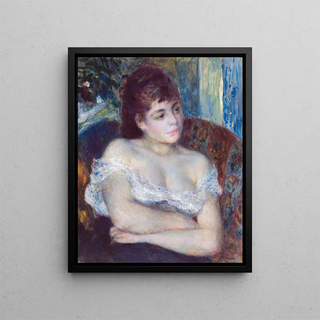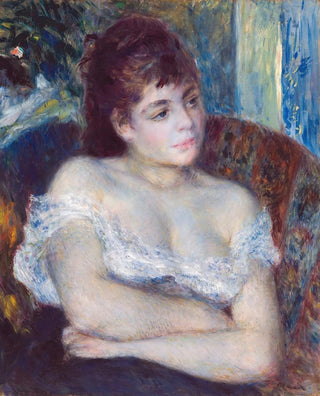Art print | Woman in an Armchair - Pierre-Auguste Renoir Source: Reproduction | Femme dans un fauteuil - Pierre-Auguste Renoir


View from behind

Frame (optional)
In the vibrant world of impressionist art, the artwork "Femme dans un fauteuil" by Pierre-Auguste Renoir stands out for its ability to capture the very essence of feminine beauty and the delicacy of fleeting moments. This painting, created in 1876, evokes an intimate atmosphere where light plays a crucial role, illuminating the face of the seated woman with unmatched softness. Renoir, master of nuances and reflections, manages to transcend mere representation to offer a visual experience that transports the viewer to a suspended moment. The woman, lost in her thoughts, embodies natural grace, while the armchair, richly decorated, seems to envelop her in a cocoon of comfort and sophistication.
Style and uniqueness of the artwork
Renoir's style in "Femme dans un fauteuil" is characterized by bold use of color and a fluid brushstroke technique that gives the piece a palpable lightness. The brushstrokes, both swift and precise, create a vibrant texture that brings the canvas to life. The chosen palette, dominated by warm and luminous tones, evokes a sense of warmth and conviviality. Renoir excels in depicting the play of light, using reflections and shadows to shape forms and emphasize volume. The woman, dressed in a delicate dress, is highlighted by subtle lighting that accentuates the softness of her complexion and the depth of her gaze. This painting is an ode to beauty, a celebration of femininity, and an invitation to contemplate the serenity of a moment.
The artist and his influence
Pierre-Auguste Renoir, an emblematic figure of the impressionist movement, left a lasting mark on art history through his innovative approach and unique perspective on the world. Born in 1841, he was influenced by his contemporaries while developing a style that was entirely his own. Renoir always sought to express the joy of living through his works, capturing scenes of everyday life, portraits, and landscapes. His penchant for vivid colors and sense of movement make him an essential artist of his time.

Matte finish

View from behind

Frame (optional)
In the vibrant world of impressionist art, the artwork "Femme dans un fauteuil" by Pierre-Auguste Renoir stands out for its ability to capture the very essence of feminine beauty and the delicacy of fleeting moments. This painting, created in 1876, evokes an intimate atmosphere where light plays a crucial role, illuminating the face of the seated woman with unmatched softness. Renoir, master of nuances and reflections, manages to transcend mere representation to offer a visual experience that transports the viewer to a suspended moment. The woman, lost in her thoughts, embodies natural grace, while the armchair, richly decorated, seems to envelop her in a cocoon of comfort and sophistication.
Style and uniqueness of the artwork
Renoir's style in "Femme dans un fauteuil" is characterized by bold use of color and a fluid brushstroke technique that gives the piece a palpable lightness. The brushstrokes, both swift and precise, create a vibrant texture that brings the canvas to life. The chosen palette, dominated by warm and luminous tones, evokes a sense of warmth and conviviality. Renoir excels in depicting the play of light, using reflections and shadows to shape forms and emphasize volume. The woman, dressed in a delicate dress, is highlighted by subtle lighting that accentuates the softness of her complexion and the depth of her gaze. This painting is an ode to beauty, a celebration of femininity, and an invitation to contemplate the serenity of a moment.
The artist and his influence
Pierre-Auguste Renoir, an emblematic figure of the impressionist movement, left a lasting mark on art history through his innovative approach and unique perspective on the world. Born in 1841, he was influenced by his contemporaries while developing a style that was entirely his own. Renoir always sought to express the joy of living through his works, capturing scenes of everyday life, portraits, and landscapes. His penchant for vivid colors and sense of movement make him an essential artist of his time.






